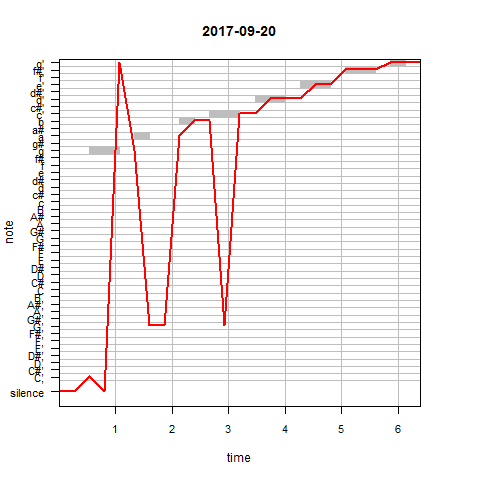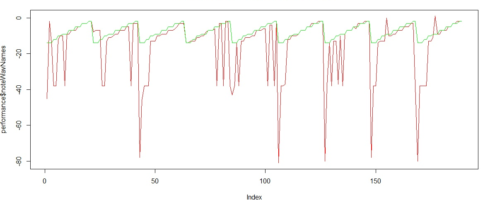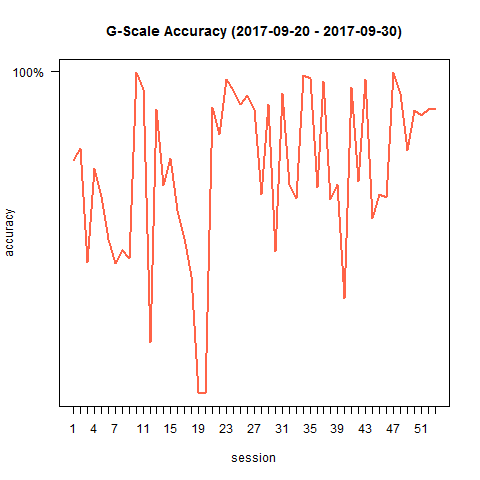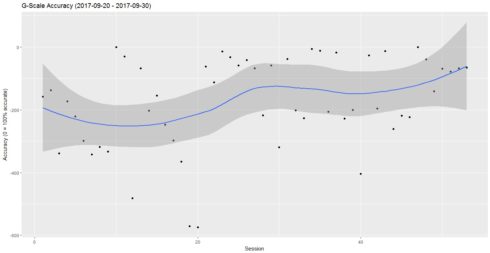A while back I finally got myself a violin (something I wanted for a long time) and I started to follow some online tutorials to learn the basics. However, being curious whether I actually have any feeling for it – I wanted to figure out if I could track my improvement (or lack thereof) in R.
My goal was to extract the notes from an example sound file and then record myself playing it to see how close my notes are to the original ones and repeat this daily to see if I am getting better. This blog post (tRanscribing music from audio files by Vesna Memisevic) was a huge help in the matter. One of the examples used was the recording of a G scale played by a violin. Since the melody is easy to repeat and it is recorded with the right instrument – this G-scale.wav was actually perfect for my objective. Therefore, I decided to track my progress by playing the G-scale every day.
The following R scripts can also be used with other .wav files as input (I also switched to other scales now) – however for this to work, the file needs to be in mono, with a bit resolution of 16 bit and a sampling rate of 16000 Hz. Not to worry though, converting a recording to those encoding settings is very easy with the online-converter.
Melody plots of daily G-scale recordings
To see the full scripts and functions that I have been using, please see the ProgressAnalysis.R and the ProgressAnalysisFunctions.R files. In what follows, I will explain the process step by step.
Read the sound file into R
First of all, let's read the original G-scale.wav file into R. This turned out to be surprisingly easy with the tuneR package (I can confirm that this works on my PC – I have a 32 bit Windows 10 laptop):
#install.packages("tuneR")
library(tuneR)
originalSound <- readWave("G-scale.wav")
play(originalSound) # opens Windows Media Player to play the sound. Beware that the window does not automatically close when the audio file is finished playing. You need to close the window before you can continue in R.
Note how the last line of this code snippet is actually playing the sound file straight from R.
Extract the frequencies and notes from the sound
My next step is to extract the frequencies and the notes from this sound. The transcribeMusic() function from the fromerly mentioned blog post does exactly this – and also it creates a melodyplot of the recording (see examples above). With the expNotes parameter you can visualize the expected notes in the plot (for the Singstar feeling).
library(tuneR)
scaleNotesFreqs<- c(NA, NA, NA, 196.00, 196.00, NA, 220.0, NA, NA, 246.9, NA, 261.6, 261.6, NA, 293.7, 293.7, NA, 329.6, 329.6, NA, 370.0, 370.0, NA, 392.0, NA)
scaleNotes <- noteFromFF(scaleNotesFreqs)
transcribeMusic <- function(wavFile, widthSample = 4096, expNotes = NULL) {
#See details about the wavFile, plot it, and/or play it
#summary(wavFile)
plot(wavFile)
perioWav <- periodogram(wavFile, width = widthSample)
freqWav <- FF(perioWav)
noteWav <- noteFromFF(freqWav)
melodyplot(perioWav, observed = noteWav,
expected = expNotes, plotenergy = FALSE,
main = Sys.Date())
#Print out notes names
noteWavNames <- noteWav[!is.na(noteWav)]
noteWavNames <- noteWavNames[1:21] # I limited the number of notes to 21 here - because that is the number of notes extracted from the G-Scale.wav file and to make comparisons later I need the extractions to be of the same length.
print(noteWavNames)
print(notenames(noteWavNames))
return(noteWavNames)
}
transcribeMusic(originalSound, expNotes = scaleNotes)
# [1] -2 -2 -2 -12 -12 -10 -10 -9 -9 -9 -7 -7 -7 -5 -5 -5 -3 -3 -3 -2 -2
# [1] "g'" "g'" "g'" "a" "a" "b" "b" "c'" "c'" "c'" "d'" "d'" "d'" "e'" "e'"
# [16] "e'" "f#'" "f#'" "f#'" "g'" "g'"
Record yourself in R
Now we know how to read a sound file into R and how to extract the notes from it. What I want to do though, is to extract the notes from my own recordings right after I played them. With the audio package it is possible to record yourself in R. Thanks to the answer in this post, I could make the following function work to record myself:
#install.packages("audio")
library(audio)
audiorec <- function(kk,f){ # kk: time length in seconds; f: filename
if(f %in% list.files())
{file.remove(f); print('The former file has been replaced');}
require(audio)
s11 <- rep(NA_real_, 16000*kk) # Samplingrate=16000
message("5 seconds..") # Counting down 5 seconds befor the recording starts
for (i in c(5:1)){
message(i)
Sys.sleep(1)
}
message("Recording starts now...")
record(s11, 16000, 1) # record in mono mode
wait(kk)
save.wave(s11,f)
.rs.restartR() # As mentioned in the above cited post: recording with the audio package works once, but for some reason it will not continue to work afterwards unless the R session is restarted. For this reason I included a restart in this function. I am hoping to find a more elegant solution one day soon.
}
]I want the original recording and my version of it to be comparable – therefore, I need my recording to have exactly the same duration as the original sound file. Let's inspect the originalSound file:
summary(originalSound) #Wave Object # Number of Samples: 100800 # Duration (seconds): 6.3 # Samplingrate (Hertz): 16000 # Channels (Mono/Stereo): Mono # PCM (integer format): TRUE # Bit (8/16/24/32/64): 16 # #Summary statistics for channel(s): # # Min. 1st Qu. Median Mean 3rd Qu. Max. #-32770.00 -6218.00 106.00 5.79 6830.00 29260.00
We can see it has a duration of 6.3 seconds and a sampling rate of 16000 Hertz (corresponds to what is specified in our recording function). Quick sidenote: if you want to learn more about the digitalization of sound and what exactly the sampling rate is – I highly recommend you to check out this introduction into sound analysis. Let's continue with the recording. Now that we know the duration that our recording should have, we can run:
# Here I create a unique filename with the current date and time (to avoid overwriting earlier recordings)
date = gsub(":","-",as.character(Sys.time()))
filename = paste0(date,"_recording.wav")
# start the actual recording
audiorec(6.3, filename)
### Wait for R to restart! ###
We need a quick restart after using the record function from the audio package. Normally (at least in my experience) the objects should appear again in the local R environment (otherwise it can be quickly solved by rerunning some parts of the script and looking up the filename of the recording).
Explore the results
Now we can extract the notes from the recording and compare them to the notes from the originalSound:
testSound <- readWave(filename) tuneR::play(testSound) results <- transcribeMusic(testSound, expNotes = scaleNotes) # the G-scale notes from the original sound in the same format: expected_notes <- c(-14,-14,-14,-12,-12,-10,-10,-9,-9,-9,-7,-7,-7,-5,-5,-5,-3,-3,-3,-2,-2) expected_notenames <- notenames(expected_notes)
Since I want to keep track of my recordings over a longer period of time, I collect the results of each recording session in a csv file. To automate this I used the following updatePerfomance() function:
updatePerformance <- function(results){
files <- list.files()
if (("performance.csv" %in% files) == FALSE){
message("No performance csv existing yet - creating it now...")
dat <- as.data.frame(results)
names(dat) <- "noteWavNames"
dat$notenames <- notenames(results)
dat$expected <- expected_notes
dat$expected_notenames <- expected_notenames
dat$date <- as.character(Sys.Date())
dat$rownum <- row.names(dat)
dat$session <- 1 # every recording gets a unique session ID
performance <- dat
write.csv2(performance, "performance.csv", row.names = FALSE)
print("Done!")
return(performance)
} else {
performance <- read.csv2("performance.csv", stringsAsFactors = FALSE)
dat <- as.data.frame(results)
names(dat) <- "noteWavNames"
dat$notenames <- notenames(results)
dat$expected <- expected_notes
dat$expected_notenames <- expected_notenames
dat$date <- as.character(Sys.Date())
dat$rownum <- row.names(dat)
session_id <- performance[nrow(performance),"session"] + 1
dat$session <- session_id
performance <- rbind(performance, dat)
write.csv2(performance, "performance.csv", row.names = FALSE)
print("Done!")
return(performance)
}
}
# Now we can add the results of the recording to our performance csv:
performance <- updatePerformance(results)
As a simple visualisation, we can plot the expected notes with our notes in the same graph to see how far off the notes of the recordings were:
plot(performance$noteWavNames, type = "l", col = "red") # the red line shows what I played lines(performance$expected,col="green") # the green line shows what was expected
To measure the accuracy of the recorded G-scale, we can calculate the difference between numeric extractions of our notes and the expected notes. This means that we can treat the recorded notes as an estimation ($ŷ$) of the expected notes ($y$) and calculate the residuals from them. With the residuals, the MSE (Mean Squared Error) can be calculated per session, per day and also per note. The closer to zero the MSE, the more accurate our recreation of the G-scale is.
plotProgress <- function(performance, by){ # we can pass in the performance df and define the variable by which we want to calculate the accuracy (MSE)
progress <- c()
for (i in unique(performance[,by])){
print(i)
dat <- performance[performance[,by] == i,]
dat$res <- dat$expected-dat$noteWavNames
mse <- mean(dat$res^2)
print(mse)
progress <- c(progress,mse*-1) # To make the visualizations of the MSE a bit more intuitive to read - I am converting them from positive to negative numbers (So when a value is closer to 0, the line goes up instead of down.)
}
plot(progress, type = "l", yaxt="n", xaxt="n",ylim = c(min(progress),0), lwd = 2, col = "tomato", xlab = by, ylab = "accuracy", main = paste0("G-Scale Accuracy (",unique(performance$date[performance$session == min(performance$session)])," - ", unique(performance$date[performance$session == max(performance$session)]),")"))
axis(2, at = 0, labels="100%", las=2)
axis(1, at = c(1:length(unique(performance[,by]))),labels = unique(performance[,by]))
return(progress)
}
As soon as we have multitude of recording sessions in our performance dataframe, we can compare the accuracy of different sessions by plotting them:
plotProgress(performance, by = "session") plotProgress(performance, by = "date") plotProgress(performance[performance$expected_notenames != "g",], by = "expected_notenames") # The G is often the most "off" note as it is the first and the last one and suffers the most from noise/irregularities. I decided to filter it out so the other notes can be inspected more properly. I can see the E is my most accurate note.
I can see a lot of ups and downs in the scores of my different sessions, but I am happy to see an overall increase in my accuracy of playing the G-scale. To take away the ups and downs and visualize the progress with a smooth line instead, we can use geom_smooth() from ggplot2:
progress <- plotProgress(performance, by = "session")
library(ggplot2)
progress <- as.data.frame(progress)
progress$id <- unique(performance$session)
ggplot(progress, aes(id,progress)) +
geom_point() +
geom_smooth() +
ggtitle(paste0("G-Scale Accuracy (",unique(performance$date[performance$session == min(performance$session)])," - ", unique(performance$date[performance$session == max(performance$session)]),")"))+
ylab("Accuracy (0 = 100% accurate)") +
xlab("Session")
As you can see, tracking your musical progress with R is not only possible but also fun. Besides, it's a great learning experience, and a good chance to explore topics like the digitalization of sound, the translation of frequencies into notes and the meaning of sampling rates.



